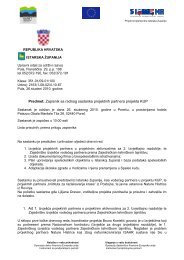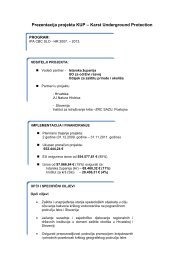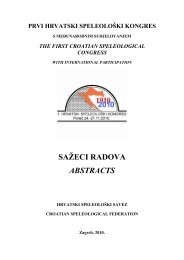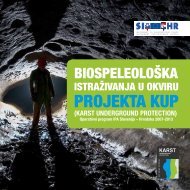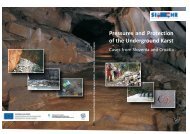Case Studies from the Dinaric Karst of Slovenia
Case Studies from the Dinaric Karst of Slovenia
Case Studies from the Dinaric Karst of Slovenia
Create successful ePaper yourself
Turn your PDF publications into a flip-book with our unique Google optimized e-Paper software.
tributions. The first phase was rich in generalideas and poor in real analyses (Roglić 1974).The second phase <strong>of</strong> karst researchThe previous research, including Penck-Grundconcept did not resolve <strong>the</strong> problem <strong>of</strong> <strong>the</strong>water circulation through fractures, fissures,and joints and its relation to <strong>the</strong> evolution <strong>of</strong>karst relief. This was explained by Vienna’sgeomorphology group member O. Lehman(1932). According to nearly forgotten Terzaghi’smarginal corrosion Kayser (1934) explains<strong>the</strong> plains at <strong>the</strong> border <strong>of</strong> Skadar Lake (Montenegro).Roglić (1938) describes and explainsaccordingly to <strong>the</strong> <strong>the</strong>ory <strong>of</strong> a border corrosionsuch terraces <strong>of</strong> <strong>the</strong> <strong>Dinaric</strong> poljes. The newconcept was largely adopted by <strong>the</strong> authors <strong>of</strong>different general or specialised works relatedFig. 6: The book Das <strong>Karst</strong>phänomen <strong>of</strong> Jovan Cvijić wasa pioneering monograph and marked <strong>the</strong> beginning <strong>of</strong>modern karst studies (Shaw 1992).to <strong>Dinaric</strong> karst. The example is <strong>the</strong> work <strong>of</strong>A. Melik, <strong>Slovenia</strong> and Sima M. Milojević, Serbia.ConclusionThe second phase was tragically interruptedby <strong>the</strong> 2 nd World War. Soon after <strong>the</strong>war investigations <strong>of</strong> karst morphology wererevived and increased in volume as well as inintensity in an essentially different way thanthose in <strong>the</strong> past. In <strong>the</strong> post-war period <strong>the</strong>reare global scientific contacts and exchanges.The different countries are easily accessible.Observations and data are multiplying, conceptsare modified and combined, sophisticatedmethods, based on computer and digitaltechnologies are widely used. With more exactobservations and data, <strong>the</strong> correspondingconclusions have been improved. In <strong>the</strong> area<strong>of</strong> <strong>Dinaric</strong> karst specially, important practicalwork in <strong>the</strong> prospection and exploitation <strong>of</strong>ore deposits has been carried out, as well as<strong>the</strong> construction <strong>of</strong> accumulation basins, hydroelectricpower plants, tunnels, railways,and motorways. Scientific concepts have necessarilybecome adapted to new ideas andfacts. So <strong>the</strong> <strong>Dinaric</strong> karst has given a lot <strong>of</strong>data and o<strong>the</strong>r material to study, <strong>the</strong>re were agreat number <strong>of</strong> authors and even much greaternumber <strong>of</strong> pr<strong>of</strong>essional and amateur works,<strong>the</strong>re are new centres working on <strong>Dinaric</strong>karst, <strong>the</strong>re are specialised journals, meetings<strong>from</strong> <strong>the</strong> World congresses to local symposia.But <strong>the</strong> same can be said for <strong>the</strong> karst all over<strong>the</strong> world. New <strong>the</strong>ories and concepts areelaborated on <strong>the</strong> knowledge <strong>of</strong> o<strong>the</strong>r karsts,not <strong>the</strong> <strong>Dinaric</strong> one. So this contribution endssomewhere with <strong>the</strong> 2 nd World War. On onehand it would require too much work and timeto analyse in detail <strong>the</strong> imposing investigations<strong>of</strong> <strong>the</strong> <strong>Dinaric</strong> karst in <strong>the</strong> last 60 years, and on<strong>the</strong> o<strong>the</strong>r hand, regarding <strong>the</strong> investigations <strong>of</strong><strong>the</strong> karst worldwide it would be too difficult t<strong>of</strong>ind out <strong>the</strong> role, <strong>the</strong> importance and <strong>the</strong> influence<strong>of</strong> <strong>the</strong> <strong>Dinaric</strong> karst studies upon <strong>the</strong>general karstology.13



